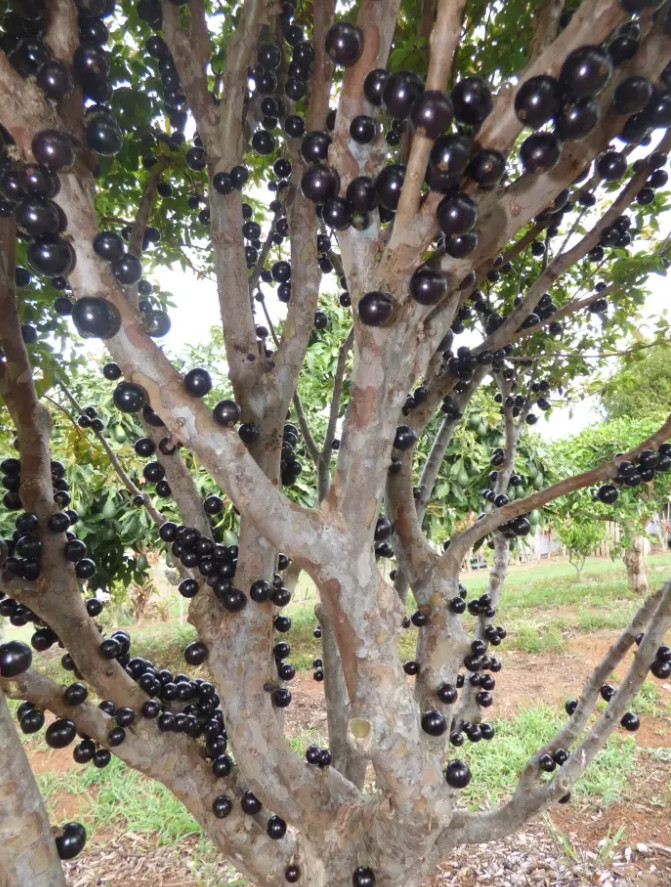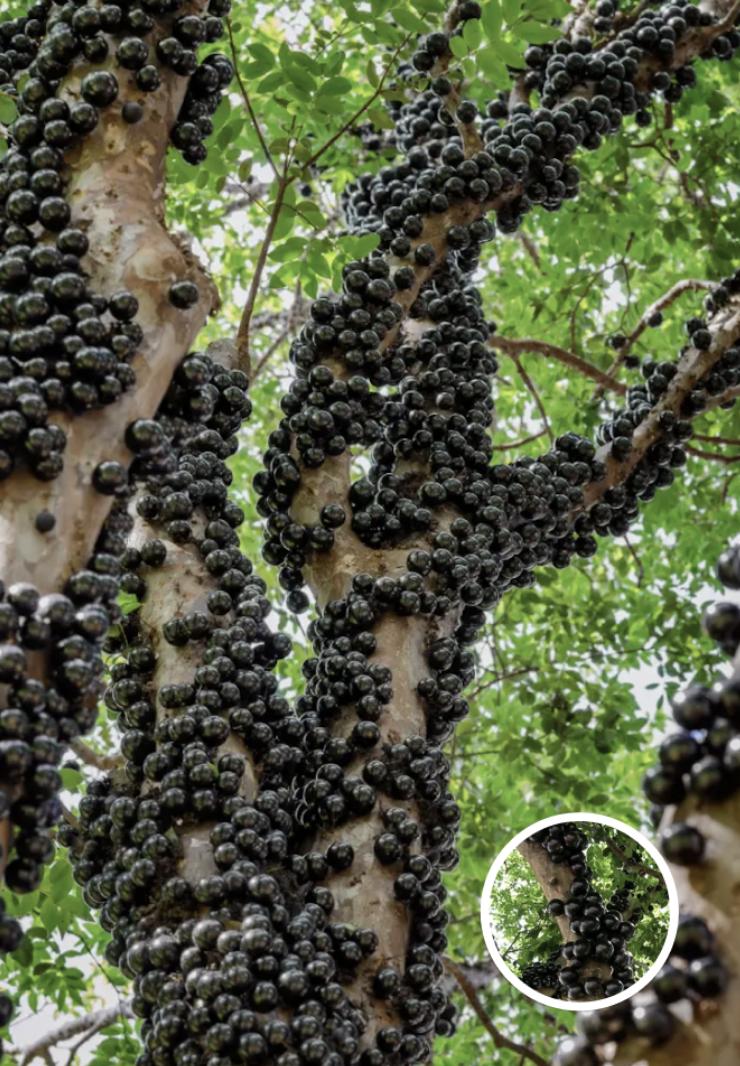The Fascinating Jabuticaba Tree: A Unique Botanical Wonder
The jabuticaba tree, scientifically known as Plinia cauliflora, is a remarkable species native to the lush landscapes of South America, particularly Brazil. This unique tree stands out not only for its striking appearance but also for its extraordinary method of producing fruit. Unlike most fruit-bearing trees that grow their produce on branches, the jabuticaba produces round, dark purple fruits directly on its trunk and larger branches, creating a visually stunning spectacle. This incredible adaptation has long fascinated botanists and nature enthusiasts alike, making it a topic of interest in both scientific circles and social media.

A Closer Look at the Jabuticaba’s Unique Fruit
The fruit of the jabuticaba is often compared to grapes due to its round shape and dark purple hue. However, jabuticaba fruits possess a unique taste profile that sets them apart. This fruit typically has a thin skin and a sweet, white, gelatinous pulp that makes it a delicious treat, whether consumed fresh or used in various culinary applications. Locals often enjoy them raw, savoring their juicy, refreshing taste, especially during the hot climate of Brazil. Beyond direct consumption, jabuticaba fruits are highly sought after for making jams, jellies, wine, and even ice cream, capitalizing on their sweet flavor and unique characteristics. The process of harvesting these fruits is also quite special, as they ripen quickly—typically within 20 to 25 days—prompting fruit lovers to stay vigilant. The short harvest cycle means that one has to be quick to gather the fruits before they fall, which adds an element of excitement to the picking process.
The Cultural Significance of the Jabuticaba
The name “jabuticaba” is derived from the Tupi language, where it translates to “place of tortoises.” This etymology points to the tree’s roots in Brazilian culture and its longstanding presence in the region. The jabuticaba holds a special place in the hearts of many Brazilians, often associated with family gatherings and traditional celebrations. The act of picking the fruits directly from the trunk is not only a delightful experience but has also become a cherished activity that brings people together, creating lasting memories. In many Brazilian homes, it is common to have a jabuticaba tree in the yard, where family members can share stories while enjoying the fruits fresh from the tree. Additionally, festivals celebrating both the fruit and the tree itself are held in various Brazilian towns, attracting visitors eager to partake in this unique cultural experience.
Environmental Adaptations and Growth Habits
The jabuticaba tree thrives in a variety of climatic conditions, predominantly in the subtropical and tropical regions of Brazil. Typically, it flourishes in well-drained soils and requires abundant sunlight to grow effectively. When fully grown, the tree can reach heights of up to 10 meters (approximately 33 feet), with a broad canopy that provides ample shade. One of the most fascinating aspects of the jabuticaba tree is its changing leaves, which transition from a soft salmon color to a rich, dark green as they mature. This vibrant transformation adds to its ornamental value, making it a popular choice among gardeners and landscapers looking to add a unique touch to their green spaces. Its adaptability not only to soil types but also to different watering practices makes it an excellent addition to diverse agricultural settings, as long as the climate is suitable.
Jabuticaba’s Rarity Outside Its Native Range
While the jabuticaba tree is a beloved part of Brazilian flora, it remains relatively rare outside its native regions. Its specific growing requirements and sensitivity to environmental changes make it challenging to cultivate in different climates. Despite this, efforts by horticulturists and plant enthusiasts worldwide to grow jabuticaba trees in suitable conditions have gained traction. In places like Florida and California, nurseries are experimenting with different techniques to mimic the jabuticaba’s native environment, such as maintaining specific soil types and humidity levels. These efforts aim to introduce this intriguing species to a broader audience, and as more people discover the jabuticaba’s unique characteristics, its popularity continues to grow, leading to an increased presence in nurseries and botanical gardens across the globe.
The Jabuticaba in the Age of Social Media
In recent years, social media platforms have played a pivotal role in spreading awareness about the jabuticaba tree and its incredible fruit. Users across platforms like Instagram and TikTok have shared stunning images and videos of jabuticaba trees in full fruit, often accompanied by tales of family traditions and personal experiences. These posts not only celebrate the tree’s aesthetic beauty but also highlight the importance of preserving such unique species. Social media has also facilitated connections among enthusiasts who share tips on growing jabuticaba and recipes for enjoying its flavorful fruit. As more people engage with these online communities, there is a growing interest in sustainable gardening practices and preserving biodiversity, with the jabuticaba tree serving as a focal point for many. Its viral appeal has inspired numerous backyard gardening trends, encouraging individuals to cultivate unique plants that contribute to both personal enjoyment and environmental conservation.
Conclusion: A Testament to Nature’s Creativity
Ultimately, the jabuticaba tree represents a stunning example of nature’s creativity and adaptability. Its unusual fruiting patterns, cultural significance, and luscious flavors contribute to a rich tapestry of life in its native environment. As awareness of this exceptional species continues to grow, so does the appreciation for the myriad ways in which nature surprises and delights us. The jabuticaba tree is not just a source of nourishment; it also serves as a reminder of the beauty and wonder that can be found in the natural world, encouraging us to cherish and protect our planet’s diverse ecosystems. Whether through its delicious fruit, its magnificent appearance, or the connections it fosters among people, the jabuticaba tree will remain an enduring symbol of nature’s ingenuity.

















